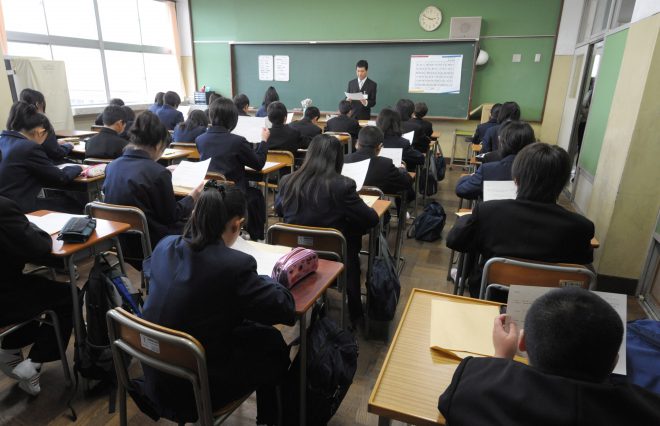Students in Japan fall short of state-set English skill goals
April 16, 2019
Tokyo--Third-year students in junior and senior high schools in Japan failed to meet respective state-set goals for English skills, an education ministry survey showed Tuesday.
The survey in fiscal 2018, which ended in March, found that 42.6 pct of third-year students in junior high schools were rated A1 or higher grades by the Common European Framework of Reference for Languages, or CEFR, an international standard for grading language ability. The figure fell short of the state-set target of 50 pct or higher.
The proportion of third-year high school students rated A2 or higher under the CEFR stood at 40.2 pct, against the government's target of 50 pct or higher.
The A1 and A2 grades are equivalent to Grade 3 and Grade Pre-2, respectively, in Japan's popular Eiken English proficiency test.
Still, the proportions of third-year junior and senior high school students who achieved the state-set goals rose from the previous year by 1.9 percentage points and 0.9 point, respectively. The figures have been on an uptrend since fiscal 2013, when the survey started.
Of Japan's 47 prefectures, Fukui saw the highest achievement rate among third-year junior high school students, at 61.2 pct. The achievement rate was also at 50 pct or higher in Chiba, Tokyo, Ishikawa and Tokushima.
In terms of the achievement rate among third-year high schoolers, Fukui also topped the list, at 56.0 pct, followed by Toyama, at 54.8 pct, and Akita, at 53.3 pct.
By contrast, Hokkaido registered the lowest achievement rate of 30.0 pct for third-year junior high school students. The lowest rate for third-year senior high school students, of 31.1 pct, was logged in Miyagi.
Of the 20 government-designated major cities, Saitama and four other cities met the achievement rate target for third-year junior high school students. Saitama topped the list, at 75.5 pct, while Hamamatsu was in the last place, at 31.2 pct.
The survey also showed that the proportions of junior and senior high school English teachers who had qualifications for English proficiency equivalent to or higher than the CEFR B2 level or Grade Pre-1 in Eiken grew to 36.3 pct and 68.2 pct, respectively. But they failed to meet their respective state-set targets of 50 pct or higher and 75 pct or higher.
The proportion of schools that use information and communications technology equipment stood at 99.0 pct for elementary schools, 95.8 pct for junior high schools and 88.6 pct for high schools.
The survey covered students who as of Dec. 1 had qualifications for English proficiency equivalent to their target levels or were judged by teachers to have such skills.
The government goals for English skills of junior and senior high school students were set under the third basic plan for the promotion of education, which was approved at a cabinet meeting in June 2018.
The education ministry plans to make efforts to improve students' English skills mainly through sharing information, such as on good examples, among prefectures, officials said. Jiji Press
Latest Videos
- THE UNTOLD STORY EXPERT INSIGHTS INTO THE UKRAINE
- NEGOTIATING A NEW ORDER US RUSSIA TALKS ON UKRAIN
- Ukraine: A Pawn in the Geopolitical Game? Will Trump Intervene?
- US VP VANCE CRITICIZES EUROPEAN DEMOCRACIES AT MUNICH SECURITY CONFERENCE
- UNCOVERING THE WEB OF DECEIT: CIA INFILTRATION OF THE MEDIA
- SHIFTING SANDS: TULSI GABBARD’S CONFIRMATION AND THE EVOLVING GLOBAL LANDSCAPE
- FAUCI SCANDAL: A THREAT TO GLOBAL HEALTH AND DEMOCRACY






